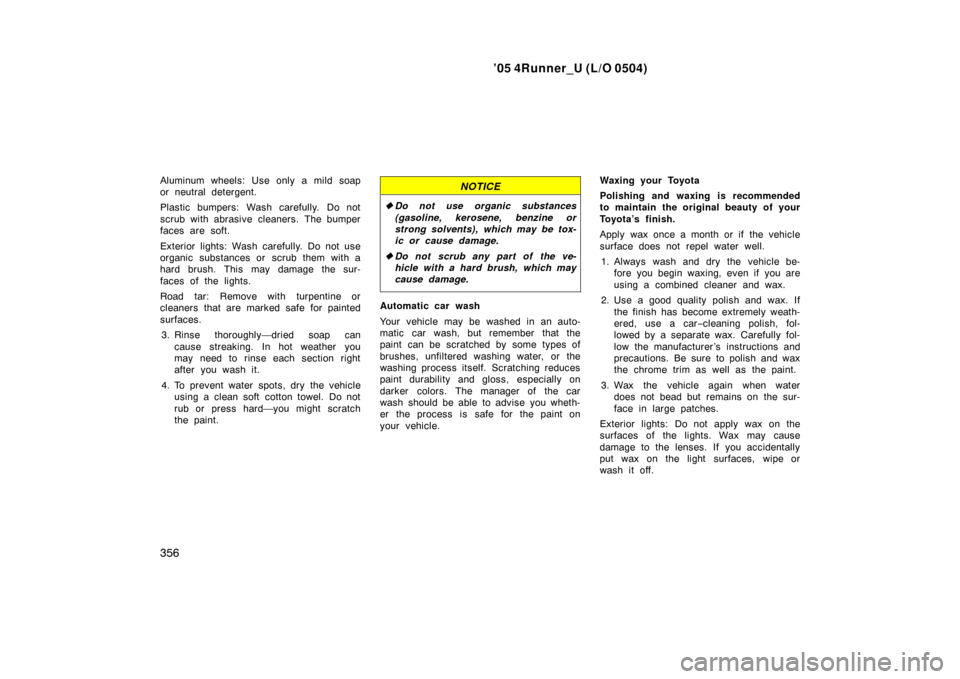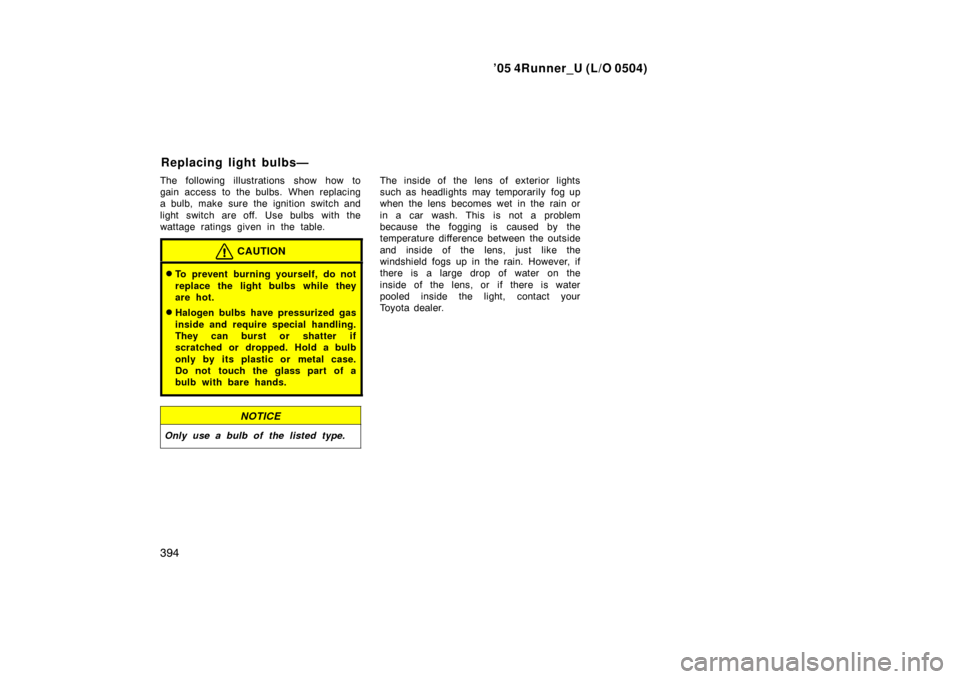Page 343 of 426

’05 4Runner_U (L/O 0504)
333
Do not connect the cable to or near
any part that moves when the engine
is cranked.
CAUTION
When making the connections, to
avoid serious injury, do not lean over
the battery or accidentally let the
jumper cables or clamps touch any-
thing except the correct battery termi-
nals or the ground.
5. Charge the discharged battery with the
jumper cables connected for approxi-
mately 5 minutes. At this time, run the
engine in the vehicle with the booster
battery at about 2000 rpm with the ac-
celerator pedal lightly depressed.
6. Start your engine in the normal way. After starting, run it at about 2000 rpm
for several minutes with the accelerator
pedal lightly depressed.
7. Carefully disconnect the cables in the exact reverse order: the negative cable
and then the positive cable.
8. Carefully dispose of the battery cover cloths—they may now contain sulfuric
acid. 9. If removed, replace all the battery vent
plugs.
If the cause of your battery discharging is
not apparent (for example, lights left on),
you should have it checked at your Toyota
dealer.
If the first start attempt is not success-
ful...
Check that the clamp on the jumper
cables are tight. Recharge the discharged
battery with the jumper cables connected
for several minutes and restart your en-
gine in the normal way.
If the another attempt is not successful,
the battery may be depleted. Have it ch-
ecked at your Toyota dealer. If your engine stalls while driving...
1. Reduce your speed gradually, keeping a straight line. Move cautiously off the
road to a safe place.
2. Turn on your emergency flashers.
3. Turn the ignition key to “ACC” or “LOCK”, and try starting the engine
again.
If the engine will not start, see “If your
vehicle will not start” on page 330 in this
Section.CAUTION
If the engine is not running, the pow-
er assist for the brakes and steering
will not work so steering and braking
will be much harder than usual.
If your engine stalls while
driving
Page 366 of 426

’05 4Runner_U (L/O 0504)
356
Aluminum wheels: Use only a mild soap
or neutral detergent.
Plastic bumpers: Wash carefully. Do not
scrub with abrasive cleaners. The bumper
faces are soft.
Exterior lights: Wash carefully. Do not use
organic substances or scrub them with a
hard brush. This may damage the sur-
faces of the lights.
Road tar: Remove with turpentine or
cleaners that are marked safe for painted
surfaces.
3. Rinse thoroughly—dried soap can cause streaking. In hot weather you
may need to rinse each section right
after you wash it.
4. To prevent water spots, dry the vehicle using a clean soft cotton towel. Do not
rub or press hard—you might scratch
the paint.NOTICE
�Do not use organic substances
(gasoline, kerosene, benzine or
strong solvents), which may be tox-
ic or cause damage.
� Do not scrub any part of the ve-
hicle with a hard brush, which may
cause damage.
Automatic car wash
Your vehicle may be washed in an auto-
matic car wash, but remember that the
paint can be scratched by some types of
brushes, unfiltered washing water, or the
washing process itself. Scratching reduces
paint durability and gloss, especially on
darker colors. The manager of the car
wash should be able to advise you wheth-
er the process is safe for the paint on
your vehicle. Waxing your Toyota
Polishing and waxing is recommended
to maintain the original beauty of your
Toyota’s finish.
Apply wax once a month or if the vehicle
surface does not repel water well.
1. Always wash and dry the vehicle be- fore you begin waxing, even if you are
using a combined cleaner and wax.
2. Use a good quality polish and wax. If the finish has become extremely weath-
ered, use a car −cleaning polish, fol-
lowed by a separate wax. Carefully fol-
low the manufacturer ’s instructions and
precautions. Be sure to polish and wax
the chrome trim as well as the paint.
3. Wax the vehicle again when water does not bead but remains on the sur-
face in large patches.
Exterior lights: Do not apply wax on the
surfaces of the lights. Wax may cause
damage to the lenses. If you accidentally
put wax on the light surfaces, wipe or
wash it off.
Page 374 of 426

’05 4Runner_U (L/O 0504)
364
Power steering fluid level
Check the level through the reservoir. The
level should be in the “HOT” or “COLD”
range depending on the fluid temperature.
See page 381 in Section 7 −2 for addition-
al information.
Exhaust system
If you notice any change in the sound of
the exhaust or smell exhaust fumes, have
the cause located and corrected immedi-
ately. (See “Engine exhaust cautions” on
page 287 in Section 2.)
INSIDE THE VEHICLE
Items listed below should be checked
regularly, e.g. while performing periodic
services, cleaning the vehicle, etc.
Lights
Make sure the headlights, stop lights, tail
lights, turn signal lights, and other lights
are all working. Check headlight aim.
Service reminder indicators and warning
buzzers
Check that all service reminder indicators
and warning buzzers function properly.
Steering wheel
Check that it has the specified free play.
Be alert for changes in steering condition,
such as hard steering or strange noise. Seats
Check that all front seat controls such as
seat adjusters, seatback recliner, etc. op-
erate smoothly and that all latches lock
securely in any position. Check that the
head restraint move up and down smooth-
ly and that the locks hold securely in any
latched position. For folding
−down rear
seatbacks and swing −up rear seat cush-
ions (vehicles without third seats), tum-
bling second seats (vehicles with third
seats), folding −up third seats and detach-
able third seats, check that the latches
lock securely.
Seat belts
Check that the seat belt system such as
buckles, retractors and anchors operate
properly and smoothly. Make sure that the
belt webbing is not cut, frayed, worn or
damaged.
Accelerator pedal
Check the pedal for smooth operation and
uneven pedal effort or catching.
Brake pedal
Check the pedal for smooth operation and
that the pedal has the proper clearance.
Check the brake booster function. Brakes
In a safe place, check that the brakes do
not pull to one side when applied.
Parking brake
Check that the pedal has the proper travel
and that, on a safe incline, your vehicle
is held securely with only the parking
brake applied.
Automatic transmission “Park” mecha-
nism
On a safe incline, check that your vehicle
is held securely with the selector lever in
“P” position and all brakes released.
OUTSIDE THE VEHICLE
Items listed below should be performed
from time to time, unless otherwise
specified.
Fluid leaks
Check underneath for leaking fuel, oil, wa-
ter or other fluid after the vehicle has
been parked for a while. If you smell fuel
fumes or notice any leak, have the cause
found and corrected immediately.
Page 402 of 426

’05 4Runner_U (L/O 0504)
392
Ty p e A
Ty p e B
Ty p e CGood Blown
Good
Good
Blown
Blown
If the headlights or other electrical
components do not work, check the
fuses. If any of the fuses are blown,
they must be replaced.
See “Fuse locations” on page 370 in Sec-
tion 7
−1 for locations of the fuses.
Turn the ignition switch and inoperative
component off. Pull the suspected fuse
straight out and check it.
Determine which fuse may be causing the
problem. The lid of the fuse box shows
the name of the circuit for each fuse. See
page 406 in Section 8 for the functions
controlled by each circuit. Type A fuses can be pulled out by using
the pull
−out tool. The location of the pull −
out tool is shown in the illustration.
If you are not sure whether the fuse has
blown, try replacing the suspected fuse
with one that you know is good.
If the fuse has blown, push a new fuse
into the clip.
Only install a fuse with the amperage rat-
ing designated on the fuse box lid.
If you do not have a spare fuse, in an
emergency you can pull out the “PWR
OUTLET” or “HEATER NO.2” fuse, which
may be dispensable for normal driving,
and use it if its amperage rating is the
same.
If you cannot use one of the same amper-
age, use one that is lower, but as close
to the rating as possible. If the amperage
is lower than that specified, the fuse
might blow out again but this does not
indicate anything wrong. Be sure to get
the correct fuse as soon as possible and
return the substitute to its original clip.
It is a good idea to purchase a set of
spare fuses and keep them in your ve-
hicle for emergencies.
Checking and replacing fuses
Page 404 of 426

’05 4Runner_U (L/O 0504)
394
The following illustrations show how to
gain access to the bulbs. When replacing
a bulb, make sure the ignition switch and
light switch are off. Use bulbs with the
wattage ratings given in the table.
CAUTION
�To prevent burning yourself, do not
replace the light bulbs while they
are hot.
�Halogen bulbs have pressurized gas
inside and require special handling.
They can burst or shatter if
scratched or dropped. Hold a bulb
only by its plastic or metal case.
Do not touch the glass part of a
bulb with bare hands.
NOTICE
Only use a bulb of the listed type.
The inside of the lens of exterior lights
such as headlights may temporarily fog up
when the lens becomes wet in the rain or
in a car wash. This is not a problem
because the fogging is caused by the
temperature difference between the outside
and inside of the lens, just like the
windshield fogs up in the rain. However, if
there is a large drop of water on the
inside of the lens, or if there is water
pooled inside the light, contact your
Toyota dealer.
Replacing light bulbs—
Page 405 of 426
’05 4Runner_U (L/O 0504)
395
A: HB3 halogen bulbs
B: HB4 halogen bulbs
C: Wedge base bulbs (clear)
D: Wedge base bulbs (amber)
E: Double end bulbs
9005
Ty p e
WBulb No.Light bulbs
Headlights (high beam)
Headlights (high and low beams)
Front fog lights
Parking and front side marker lights
Front turn signal lights
(without daytime running light system)
Front turn signal lights
(with daytime running light system)
Rear turn signal lights
Stop/tail and rear side marker lights
Back −up lights
License plate lights
High mounted stoplight
Interior light
Personal lights
Vanity lights
Door courtesy lights
Glove box light
Luggage compartment light
Running board lights 9006
9006
168
—
—
—
—
921
—
—
— —
—
921
168 —
4157NAK 60
51
51
5
21
27/8 21
21/5 165
16 8
5
3
3.8
1.2 8
3.8 A
B
B
D
D
D
D
C
C
C
C E
C E
C
C E
C
Page 406 of 426
’05 4Runner_U (L/O 0504)
396
Low beam
(outside)
High beam
(inside)
1. Turn the bulb base counterclockwise to the front of the vehicle as shown.2. Unplug the connector while depress-ing the lock release.
If the connector is tight, wiggle it.3. Install a new bulb and connector into the mounting hole and turn
them clockwise to the front of the
vehicle.
Aiming is not necessary after replacing
the bulb. When aiming adjustment is nec-
essary, contact your Toyota dealer.
—Headlights
Page 407 of 426
’05 4Runner_U (L/O 0504)
397
1. Turn the bulb base counterclockwise
to the front of the vehicle as shown.2. Unplug the connector while depress-ing the lock release.
If the connector is tight, wiggle it.3. Install a new bulb and connector into the mounting hole and turn
them clockwise to the front of the
vehicle.
—Front fog lights